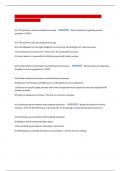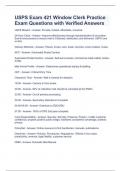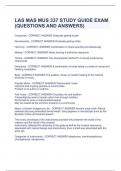Generalisable introductory [Insert theme] is purportedly enshrined within the constitution OR represents one of the founding
paragraph principles of America.
The Declaration of Independence (1776) argues that “all men are created equal” and thus afforded the
right to “life, liberty and the pursuit of happiness”.
Indeed, the earliest understandings of the American Dream recall these founding values.
Sarah Churchwell notes that before the American Dream became synonymous with “the individual
pursuit of prosperity”, it was one of “representative democracy” and “national self-government”.
These two ideals were conflated in the public consciousness by James Truslow Adams as a “better and
richer and fuller life for everyone, with opportunity for each according to ability or achievement”.
Thus, the literature would appear to define a country that [tailor to theme].
Both Fitzgerald’s The Great Gatsby (1925) and Larsen’s Passing (1925) initially appear to evidence this
[theme] but go on to expose its corruption, typical of the “national self-criticism” on the grounds of “social
inequality” that Lawrence Buell identifies with a category of works he terms the ‘Great American Novel’.
“Anything but patriotic”, many twentieth century American writers cast doubt on the rags-to-riches
archetype using a subversion of the “up-from narrative”.
Fitzgerald and Larsen, it can be argued, are no exception
Good contemporary reference: The slogan, “Make America Great Again”, helped Donald Trump win the
election in 2017 and demonstrates an understanding of the importance of American exceptionalism in US
electoral politics
Symbols Light The green light “Irene finished her cigarette and threw it out,
/ motifs watching the tiny spark drop slowly down to the
light below”
“A vital glowing thing, a flame of red and gold”
Colour Daisy’s “white girlhood”, “white roadster”, “white Clare is “exquisite, golden, fragrant, flaunting” - in
dresses” and “white palace” emphasise her purity (D. recognition of her wealth, Clare is also associated with
Morton). Daisy is always linked with white as well as the colour gold. Also like Daisy, Clare’s beauty is not of
gold, so that there is always a dual association of an innocent, virginal sort and it is largely because she
innocence as well as wealth. But Daisy’s sexual is “capable of heights and depths of feeling” that Irene
experience and her abandonment of Gatsby at the end admits she “had never known” that she is such a
, of the novel renders the emphasis on her innocence source of “fascination, strange and compelling”
ironic, lending it credence only as a performative
aspect of her “absolutely perfect reputation”. Daisy’s
looks are never described: an impressionist effect is
achieved largely through the use of colour to suggest
the impact of her sexuality on men
Clothes “He was so hard up he had too keep on “Pathetic red frock”
wearing his uniform because he couldn’t buy “Stately gown of black taffeta”
some regular clothes” “Cinnamon-brown frock that brought out all her
“Shirts of sheer linen and thick silk and fine vivid beauty””
flannel” “Priceless velvet of her dress”
“Coral and apple-green and lavender and faint
orange with monograms of indian blue”
Letters Letters in both ‘The Great Gatsby’ and ‘Passing’ “Purple ink [...] foreign paper of extraordinary
represent Nick and Irene’s respective inductions into size”
“riotous” worlds, and complex emotional landscapes, Deborah E MacDowell reads into the yonic
they have hitherto been sheltered from imagery of an envelope and sees the letter as a
The “majestic hand” of Gatsby’s invitation to metaphorical vagina, symbolic of the sexual
Nick possibilities that Clare represents, and that
Irene desires, but has suppressed
Ghosts “A new world, material without being real” “A match had been struck, revealing ghastly
populated by “pale ghosts, breathing dreams shapes where there had once only been
like air” shadows”
“Lost the old warm world” - “looked up an “All of life had changed, lost its colour, its
unfamiliar sky through frightening leaves and vividness, its whole meaning”
found what a grotesque thing a rose is” Just like Gatsby, whose “career as Trimalchio was
The notion that the characters, especially the ”ashen, over”, Irene withdraws from entertaining and social
fantastic figure” of George Wilson, exist as “ghosts” events as the central crisis of the novel looms. Her
indicates their fundamental passivity and lack of social life, once so carefully cultivated, is now
control. Social forces and constructs (class status), dismissed - “what did it matter?” - as she comes to
rather than individual characters, determine human realise its hollow, superficial basis. In line with
behaviour. This links The Great Gatsby to the literary modernist techniques, both novels use imagery of
, genre of naturalism, which is also associated with shadows and ghosts to suggest the subjective nature
Theodore Dreiser’s Sister Carrie of experience and perception
Eyes T.J. Eckleburg’s eyes are like those of the characters: Clare’s “Negro eyes” are a source of perpetual
vacant and morally blind. Their disembodiment - the fascination, and anxiety, for Irene
fact that they “look out of no face” - speaks to the Irene is discomforted by the notion that Clare’s
dislocation of the new American Dream, driven by eyes are always secretly “mocking” her
acquisition and consumerism and unmoored from any She is initially disturbed by the intensity of
solid spiritual grounding. Loss of guiding religious Clare’s stare on the roof top of the Drayton,
principles in an industrialised economy is a common fearful of being seen, and “declared”, as a
preoccupation of Modernist writers, like Fitzgerald “Negro” during a moment of ‘passing’
Society has discarded traditional ethics and Clare’s penetrating gaze threatens to expose
beliefs and replaced them with the prevailing and bring to the surface the sexual self that
power of materialism, producing fabulous Irene has long buried (A. DuCille: Clare is
wealth at one extreme and ailing “ghost[s]” at Irene’s “alter libido”)
the other Like Irene, Nick in The Great Gatsby is “conscious of
K. Parkinson: Eckleburg’s eyes are Fitzgerald’s wanting to look squarely at everyone and yet avoid all
“most memorable image of a society existing in eyes”. References to T. J. Eckleburg - regardless of
a moral vacuum” whether he represents an impotent or a judging God -
The motif of eyes also represents the characters’ fears remind us that this is impossible: “God knows what
of being seen for who they really are. To varying you’ve been doing, everything you’ve been doing”
extents, all hide “insensate selfishness” (E. Clarke)
beneath an attractive exterior
Moonlight / Gatsby and his house are frequently associated with Clare Kendry, “like a sunlit day”, and Ralph Hazelton,
sunlight moonlight or starlight; both “dispense starlight to “like a moonlit night”: High Wentworth’s aestheticism
casual moths”. Gatsby’s “reveries” are set against the imposes a reductive dimension on race relations,
backdrop of moonlight which “soaked with wet light his seeing complex social dynamics as a mere “study in
tangled clothes upon the floor”. Moonlight is contrasts” for his own enjoyment. His “artistic or
traditionally associated with the romantic imagination, sociological interest in the race” has echoes of
with an intense subjective experience of solitude and primitivism - a fascination with a culture seen as
desire for the unattainable ideal distanced, apart from and in contrast to modern
civilised society
Precious Daisy, as the object of Gatsby’s intense feeling, is Clare is often referred to as “golden”, which both








